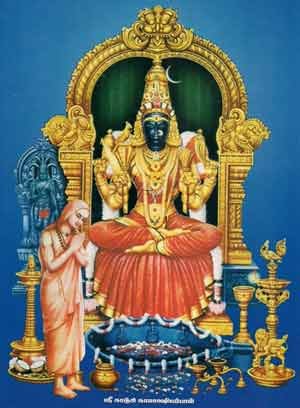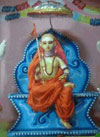Adi Shankaracharya & His Connection with Kanchipuram
A book By Sri A. Kuppuswami, B.A., B.T.
|
SRI SHANKARACHARYA AND HIS CONNECTION WITH KANCHIPURAM |
|
 |
APPENDIX-II General Editor -Professor K.A.NILAKANTA SASTRI “Another matha was originally located at Kanchi and was known as the Kamakoti Pitha, in honour of the Goddess at Kanchi. This also appears to have been ruled by a regular succession of pontificial heads. |
Inscriptional records show that this matha was at Kanchi at least in thirteenth century, for a record of Vijayagandagopala, the Telegu Coda King, registers a grant to the matha at the place in 1293 A.D. From the very beginning of its foundation the matha appears to have been presided over by a regular succession of pontiffs. Among them mention maybe made of Vyasacala, Candracuda, Sadasivendra, Paramasivendra the guru of Sadasiva Brahman of Nerur, and Atmabodhendra at whose instance Sadasiva Brahman composed the Gururatnamala and Nama Bodhendra. According to a list of the acharya of this matha published by T.S. Narayana Sastri, the 55th Acarya in the apostolic line was one Candracudendra who presided over it between 1506 and 1512. And the next was one Sadasivendra who presided over it between 1512 and 1538. According to two copper plates of 1507(?) Vira Narasimha made two grants of villages to one Mahadeva Sarasvati, the then presiding pontiff of the Kanchi Kamakoti Pitha. IN 1522 A.D. Krsnadeva Raya made a grant of two villages to Candracuda Sarasvati, the disciple of Mahadeva Sarasvati. (E.I.xiii,pp,122-132). He is called Sivacetas (having his mind devoted to Siva). Yatiraja (prince among ascetics)and Dhimat (Philosopher). He is also said to have been a great expounder of the doctrine of Maya. In the light of the date of this inscription and of the two others of Vira Narasimha and the names of the pontiffs, we have to doubt the value of the chronology of Narayana sastri’s list. (According to Guruparamparastava, Purananada , the guru’s guru of Chanderasekhara, went on a pilgrimage to Nepal. Buhler mentions an epigraph which refers to the fact that a svami of South India named Somasekharananda went to Nepal in 1503 A.D. An inscriptional evidence from Nepal corroborates the tradition contained in the Guruparampara of the Shankaracharya math; there can be no denying the fact that a svami of the math went to Nepal S.V.Venkatesvara observes that “the svami referred to must be either the done of our grant (Chandrasekhara) or his guru’s guru, Purananda alias Candracuda. “But since Buhler gives the date of the Svami’s visit to Nepal and since the donee of the above grant (Chandrasekhara) could have been living a that time as the prospective successor to the pontificial throne, we can say that it was he that went to Nepal for the names Somesekhara and Chandrasekhara are synonyms. In the face of such clear evidence we need not suppose that Purnanda might have gone to Nepal. See E.I.xii pp.125 ff.) Candracuda Sarasvati or Chandrasekhara Sarasvati was succeeded, in apostolic line, by Sadasiva Sarasvati. He is said to have been the disciple of Chandrasekhara Sarasvati, apparently another name of Candracuda who was a Paramahamsa and Parivrajakacarya. This succession is corroborated by the list of Narayana Sastri also. Sadasiva was the recipient of a grant of the village of Udayambakkam in the Chinglepet district by Krsnadeva Raya in 1528 A.D. Thus he appears to have succeeded Chandrasekhara Sarasvati between 1522 and 1528 A.D; but we are not able to know the exact date. He compiled the Punyaslokamanjari containing the succession list of the pontiffs of the Kamakoti Pitha. But some time later this mantha seems to have been shifted to Gajaranyaksetram or Jambukesvaram near Trichinopoly. In 1708 A.D. Vijaya Ranga Cokkanatha Nayaka of Madura made a grant of land for maintaining worship and for feeding Brahmans in the Shankaracharya matha at the place. The copper plate inscription states that this matha was located in the street called Ponvasikondan Street, at the village and had been in the Possession of the pontiff from very early times. But the building which is pointed out as the original one where the matha was located does not appear to be correct according to the Government epigraphist. This apart we do not know why and when the matha was transferred to Tanjore on account of the fact the Conjeevaram was attacked frequently by the muhammadans. Hence it was shifted to Kumbakonam. |
|
| Book Index Page |  |
Appendix III - Some References to Shankaracharya in Inscriptions |
Back to Page - Focus Adi Shankaracharya